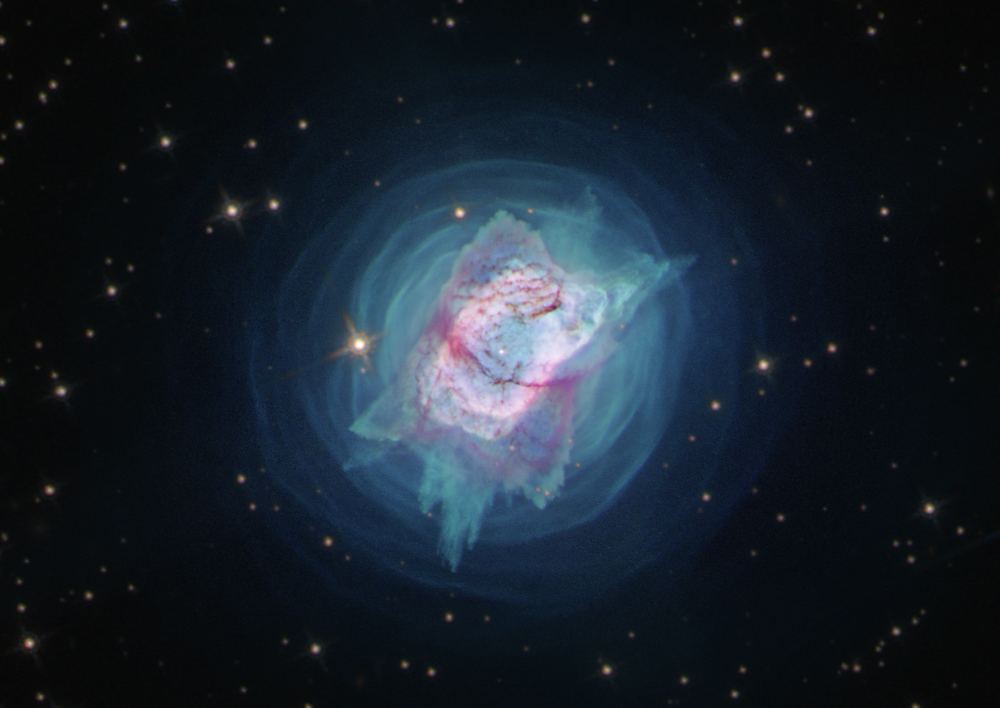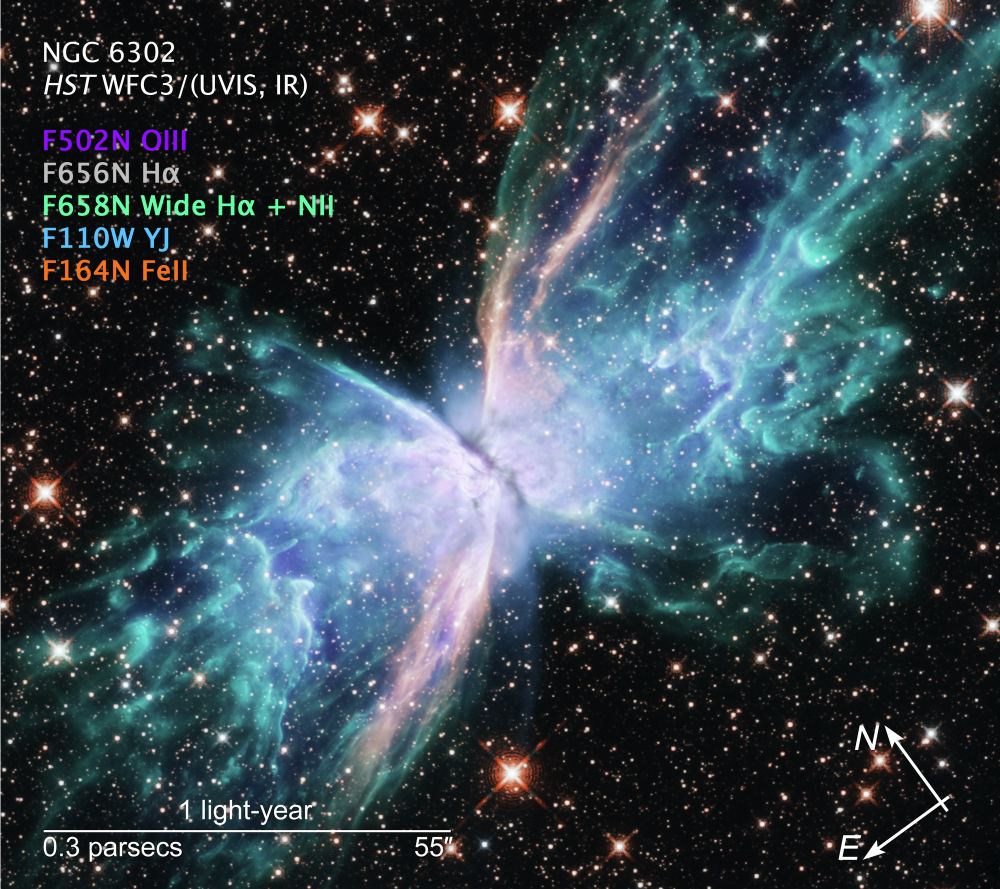Planetary nebulae are astronomy’s gateway drug. Their eye-catching forms make us wonder what process created them, and what else is going on up there in the night sky. They’re some of the most beautiful, ephemeral looking objects in all of nature.
The Hubble Space Telescope is responsible for many of our most gorgeous images of planetary nebulae. But the images are more than just engrossing eye candy. They’re documentation of a complex process that plays out over tens of thousands of years, all across the Universe.
And they’re a death knell for the star that dwells within.
The name can throw us off; there’s nothing planetary about them. But early astronomers didn’t have the high-resolution images that we take for granted now. They had to look at the sky through all sorts of homemade contraptions, some better than others. It may have been the English astronomer William Herschel who first coined the term “planetary nebula” when he described the objects as planetary in appearance back in the 1780s.
But there’s nothing planetary about them.
At the heart of each nebula is a star, shedding its gaseous layers into space, and lighting those nebulous forms up with its own light.
In an effort to grow our understanding of planetary nebulae, a team of researchers used the Hubble Space Telescope to examine a pair of well-known nebulae in greater detail. The lead author of the new paper is Joel Kastner of the Rochester Institute of Technology. The paper’s title is “First Results from a Panchromatic HST/WFC3 Imaging Study of the Young, Rapidly Evolving Planetary Nebulae NGC 7027 and NGC 6302. It’s published in the journal Galaxies.
A regular star like our Sun has a pretty steady, stable life. It can expect about 10 billion years of predictable nuclear fission. But then it starts to run out of hydrogen, and that signals a big change in its fortunes.
Each star is a balancing act between the outward pressure of its fusion, and the inward pressure of its own gravity. The two forces are largely in balance, and for stars like the Sun, that balance lasts a long time. But everything has an end.
As the hydrogen runs out and the star loses enough mass, the star expands and turns into a red giant. This is the fate of all intermediate mass stars, between 1 to 8 solar masses, and it’s the eventual fate of our own Sun.

Once that red giant has expelled its atmosphere, all that remains is the luminous core of the star. The ultraviolet radiation from the star ionizes the ejected gas from the star’s atmosphere. That material then lights up, forming the beautiful shapes left for us to gaze at.
So astronomers know, in broad strokes, what’s going on with nebulae. But some of the complex shapes they make are still puzzling. Though some are spherical, the majority of them have very complex shapes and structures. The researchers behind this new study wanted to find out more about these shapes and what causes them.
“As I was downloading the resulting images, I felt like a kid in a candy store.”
JOel Kastner, Lead Author, Rochester INstitute of Technology
Their work focused on two planetary nebulae: NGC 6302 and NGC 7027.
NGC 6302 is better known as the Butterfly Nebula, an obvous moniker when you take a look at it. Its central star is one of the hottest stars astronomers know of, and the nebula is one of the most complex ones ever seen.

NGC 7027 has another name too: the Jewel Bug. The Jewel Bug is one of the youngest nebulae, only 600 years old. It’s also one of the brightest, and is the most extensively studied nebula.

For this pair of nebulae, it’s the first time they’ve been studied in this multi-wavelength view. Only the Hubble is able to study these objects simultaneously from near-ultraviolet to near-infrared light.
As is obvious from looking at them, there’s a lot going on in these nebulae. There are clumps and tendrils, bubbles and streamers. The new Hubble images are giving these researchers some new insight into what’s behind all this gorgeous chaos.
“When I looked in the Hubble archive and realized no one had observed these nebulas with Hubble’s Wide Field Camera 3 across its full wavelength range, I was floored,” said Joel Kastner of Rochester Institute of Technology, Rochester, New York, leader of the new study. “These new multi-wavelength Hubble observations provide the most comprehensive view to date of both of these spectacular nebulas. As I was downloading the resulting images, I felt like a kid in a candy store.”
The new images paid dividends right away. They showed that both nebulae are splitting themselves apart rapidly. That’s allowed the astronomers to take note of changes over the last couple decades.
“The nebula NGC 7027 shows emission at an incredibly large number of different wavelengths, each of which highlights not only a specific chemical element in the nebula, but also the significant, ongoing changes in its structure,” said Kastner.

One of the puzzling things about these objects is their transition from a red giant, or Asymptomatic Giant Branch star with slow stellar winds, to the early planetary nebula stage with much faster winds. The winds speed up from about 10–20 km s-1 to about 100–300 km s-1 as the intermediate mass stars begin to die. There’s a broad scientific consensus that these changes, and the forms they create, are driven by the interactions between a binary pair of stars in the nebulae rather than a single star.
As the pair of stars circle each other, they eventually come close enough to interact. The interaction produces a disk of gas around one or both stars. That disk then becomes the source of gas that’s emitted by the central star, forming the complex patterns we see.
The pair of stars can have another interaction too. If the smaller of the binary pair of stars merges with its swollen sibling, it can create outflowing jets of material, and over time those jests can wobble. The wobbling can create symmetry, like the “wings” of the Butterfly Nebula. These types of wings of outflowing jets are common in nebulae.

“The hypothesis of merging stars seems the best and simplest explanation for the features seen in the most active and symmetric planetary nebulas.”
Bruce Balick, Co-Author, University of Washington
The thing is, nobody’s ever seen the companion stars. But it’s still the best explanation, according to co-author Bruce Balick of the University of Washington in Seattle.
“The suspected companion stars in NGC 6302 and NGC 7027 haven’t been directly detected because they are next to, or perhaps have already been swallowed by, larger red giant stars, a type of star that is hundreds to thousands of times brighter than the Sun,” Balick said in a press release. “The hypothesis of merging stars seems the best and simplest explanation for the features seen in the most active and symmetric planetary nebulas. It’s a powerful unifying concept, so far without rival.”
In the image of the Butterfly Nebula, the Hubble used a filter that records the near-infrared emission from singly ionized iron atoms. That iron appears as a red “S” shape, that “traces the southern interior of the east lobe rim and the northern interior of the west lobe rim,” as the authors of the study write.
The S is gas being blown out of the central region at high speed.
![An image from the study. Color overlay of Cycle 27 HST/WFC3 narrow-band images of NGC 6302, the Butterfly Nebula. Filter F343N ([Ne v]) is blue, F128N (Pa?) is green, and F164N ([Fe ii]) is red. North is up and east is to the left. Image Credit: NASA/ESA/Hubble, Kastner et al, 2020.](https://www.universetoday.com/wp-content/uploads/2020/06/Iron-S.jpg)
“The S-shape in the iron emission from the Butterfly Nebula is a real eye-opener,” Kastner said. The S-shape directly traces the most recent ejections from the central region, since the collisions within the nebula are particularly violent in these specific regions of NGC 6302. “This iron emission is a sensitive tracer of energetic collisions between slower winds and fast winds from the stars,” Balick explained. “It’s commonly observed in supernova remnants and active galactic nuclei, and outflowing jets from newborn stars, but is very rarely seen in planetary nebulas.”
“The fact that the iron emission is only showing up along these opposing, off-center directions implies that the source of the fast flows is wobbling over time, like a spinning top that’s about to fall,” added Kastner. “That’s another tell-tale sign of the presence of a disk, which directs the flow, and also a binary companion.”
The Jewel Bug Nebula, or NGC 7027, lacks the symmetrical outflowing jets of its counterpart. For centuries it’s been blowing out gas in a nearly-spherical shape. This is seen as the concentric rings on the outside of the nebula. But that changed in recent times.
“In some respects, the changes within this nebula are even more dramatic than those within the Butterfly,” Kastner said. “Something recently went haywire at the very center, producing a new cloverleaf pattern, with bullets of material shooting out in specific directions.”
![An image of the study. Color overlay of Cycle 27 HST/WFC3 narrow-band images of NGC 7027. Filter F343N ([Ne v]) is blue, F502N ([O iii]) is green, and F164N ([Fe ii]) is red. North is up and east is to the left. Image Credit: NASA/ESA/Hubble; Kastner et al, 2020.](https://www.universetoday.com/wp-content/uploads/2020/06/STScI-H-p2031e-d-1280x720-1-1024x576.jpg)
The intricate and stunning patterns in the Jewel Bug nebula likely have a different cause. They’re still created by interactions between two stars. But in this case, a red giant star may have swallowed its companion.
“We have a sneaking suspicion that this nebula is a great example of what happens when a red giant star abruptly swallows a companion,” co-author Rudolfo Montez Jr. said. Montez Jr. is from the Center for Astrophysics | Harvard & Smithsonian.
The nebulae in this study are two of the youngest and most rapidly-evolving planetary nebulae that we know of. For decades, this pair has served as a benchmark in the study of nebulae. They represent two classes of planetary nebulae, both shaped by different binary pair interactions. They’re structurally complex, and full of scientific detail.
They’re also simply beautiful.
More:
- Press Release: HUBBLE PROVIDES HOLISTIC VIEW OF STARS GONE HAYWIRE
- Research Paper: First Results from a Panchromatic HST/WFC3 Imaging Study of the Young, Rapidly Evolving Planetary Nebulae NGC 7027 and NGC 6302
- Universe Today: A Planetary Nebula Like This Will Only be Visible for About 10,000 Years Before it Fades Away
